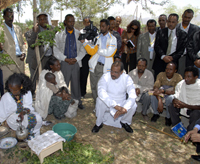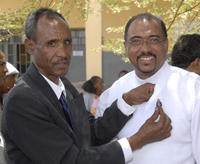
UNAIDS Executive Director Michel Sidibé joins a village “community conversation” in the Tigray Region of Ethiopia, 800kms from Addis Ababa, 22 April 2009. Credit: UNAIDS/Y.Gebremedhin
Across Ethiopia, community initiatives and local government are coming together to make a difference in the AIDS response. During his official travel to the country, UNAIDS Executive Director Michel Sidibé visited some of the programmes and projects putting into action the goals of universal access to HIV prevention, treatment, care and support services.
Adegude Health Center
At the heart of health service delivery in Ethiopia are the government-run local health centres which deliver primary health services such as family health, communicable disease prevention and control, including HIV, and health education.
Michel Sidibé was invited to visit the Adegude Health Center, one of five local health centres in Hintalowagrit District, which provides voluntary HIV counseling and testing services, as well as prevention of mother to child transmission and HIV treatment. Staff working at the centre gave an overview of the HIV services that they deliver in this rural area of Ethiopia to Mr Sidibé and shared their achievements as well as the challenges they face. District health office officials also shared experience of coordinating the multi-sectoral AIDS response, implementation of HIV programmes and service delivery.
Community conversations
Governments, people living with HIV, civil society leaders, and partners—we all need creative platforms to join in open discussion of the issues and identify ways to move forward together in the AIDS response.
Michel Sidibé, UNAIDS Executive Director
Mr Sidibé also had an opportunity to observe one of the “community conversations” in Hiwane Kebele where a cross-section of people—women and men, old and young, people living with HIV, representatives from women’s associations and youth groups join local religious and traditional leaders who have the ability to influence and bring change—regularly come together.
“Community conversations” are taking place across rural Ethiopia and studies show that they can be agents of change in the AIDS response. Once a week or fortnight in villages, or “Kebeles”, up to 70 people gather for a couple of hours with trained local facilitators to exchange their views on a range of social topics.
The village gatherings enable taboos to be aired and misunderstandings about sex and AIDS to be clarified. Traditional practices that may be factors in the spread of HIV are also discussed.
The “conversations” have changed opinion and even translated into action. For example, in some localities groups have condemned early marriage and committed to protecting school girls from discontinuing their education. Others decided to stop female genital cutting in their areas or some participants reached a consensus to avoid practices like widow inheritance. The importance of leveraging AIDS responses to deliver broader development results including gender equality and human rights is a point often emphasized by Mr Sidibé.
The local events also enable issues—such as stigma—to be explored collectively and can be a forum from which community actions are initiated such as HIV prevention, home based care, support for orphans, and increased take up of voluntary counselling and testing.
Facilitators explained how community conversations were first developed by UNDP and piloted from 2003 to 2004 in Ethiopia. The pilot was more successful than expected and federal authorities have since made community conversations a priority strategy for community mobilization across the country.
“The local community conversation I have witnessed is an inspiration. Governments, people living with HIV, civil society leaders, and partners—we all need creative platforms to join in open discussion of the issues and identify ways to move forward together in the AIDS response,” said Mr Sidibé.
People living with HIV in the region

(from left): Hailemariam Kiflay, Chairperson of “Save the Generation Association” gives a pin to Mr Sidibé during his visit with this umbrella network of people living with HIV in Tigray. Credit: UNAIDS/Y.Gebremedhin
The Executive Director also met with the Chairman and Board Members of the “Save the Generation Association Tigray” umbrella network of people living with HIV in Tigray National Regional State. The Network promotes the rights of its members, fight stigma and assists regional efforts to scale up HIV prevention, treatment, care and support services. According to the Federal Ministry of Health an estimated 62,000 people are living with HIV in the region and 63% of those in need of HIV treatment have access to it.
Care and support of vulnerable children
Around 650,000 children have been orphaned by AIDS in Ethiopia. Mr Sidibé visited a care and support project for orphans and vulnerable children and affected families in Mekelle. The project, run by Human Being Association of Brotherhood, began in 2001 to support orphans and vulnerable children and families under difficult circumstances and today provides basic and educational support to over 1000 families caring for orphans and vulnerable children. It also provides vocational training, equipment and seed money to street children and child sex workers to enable them to have their own income and continue their education. Other support services include reuniting street children with extended families and legal support for children to inherit property and pensions of their families who died of AIDS-related illnesses.
The Ethiopian Minister of Health Dr Tedros Adhanom accompanied Mr Sidibé on these site visits.
The government of Ethiopia has set ambitious targets to achieve universal access to HIV prevention, treatment, care and support and developed a multi-sectoral Plan of Action for 2007 to 2010. This was developed in consultation with a broad range of stakeholders, who shared lessons learned during implementation of the AIDS response. The plan includes detailed activities, targets, cost estimations and a financial gap analysis and represents a major step towards the realization of the ‘Three Ones’ principles.





